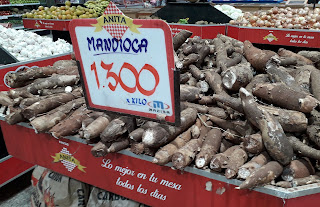Manihot Esculenta as it is known amongst scientists is a central part of every Paraguayan meal. Here it is known as mandioca or manioc and a dish without a side plate filled with it would be incomplete.
In English mandioca is know as cassava and it is a New World root tuber related to the yam and potato. Like them is has a very high starch content and is a mayor source of carbohydrates.
Mandioca was one of the first crops to be domesicated. This was initially occured in the Amazon basin at some point before 5000BC. From there it’s cultivation spread across the tropical and sub tropical Americas before travelling over the past few hundred years through trade and conquest across Africa and Asia where it has also become an important source of carbohydrates.
The plant itself with the addition of heat is very easily grown and being drought resistant tolerates the most marginal of conditions. Sewing of mandioca requires nothing more tossing a small fragment of it’s woody stem into a whole in the ground. From each of these a new plant will grow.
Mandioca does have a reputation as a lazy crop. This is as beyond keeping down the weeds nothing more need be done with the crop prior to harvesting.
Even at harvest time there is no urgency to dig the crop up for mandioca does not rot if left for extended periods in the ground. Instead the longer the tubers are left the greater they swell and the larger they grow. In doing so they remain edible and do not grow woody as other plants might.
In light of this it is common for a family to plant a vast field far in excess of what is needed for one year and then to pull plants from the ground a few at a time as and when required.
These days though many homes are without fields of their own so purchase their mandioca in sacks of the of lorries or ox carts or from the fresh vegatables section of the supermarket.
The tubers themselves are long, straight and rounded tapering at the base. One plant may produce half a dozen or more of these tubers. Each is wrapped in a thick brown skin which must be removed to reveal the white flesh before the mandioca can be cooked.
And cooked it must be for all cassava contains traces of cyanide which must be removed before it is safe to eat. There are classes of cassava, bitter and sweet. The sweet variety is so called not because it is actually sweet, but because it is not bitter.
The bitterness is caused by the cyanide and other chemicals. Bitter varieties require a lot of careful processing to render safe. The sweet however have less harmful substances to remove and so can be made safe by simple boiling. Unsurprisingly the cassava grown in Paraguay as mandioca is all of sweet varieties.
Across Paraguay every day mandioca plants are pulled from fields and gardens to be taken back to the house to be pealed and boiled so that where in some countries there would be a plate of bread there is a plate of freshly cooked mandioca on the table.


Recent Comments